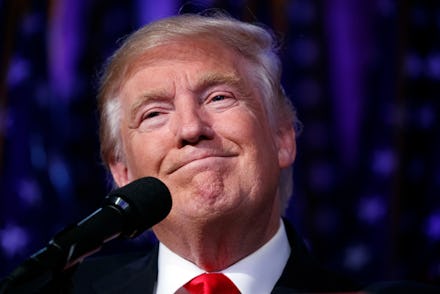What will the first 100 days of a Trump presidency look like?

On Oct. 22, President-elect Donald Trump, still forging his path to the White House, laid out his plans in Gettysburg, Pennsylvania, for his then-theoretical first 100 days in office. His speech reflected a two-page contract he issued to the American people, in which he laid out his objectives.
Republican Senate Majority Leader Mitch McConnell responded Wednesday in a press conference to Trump's proposed plan for his first 100 days in office.
While McConnell did not embrace the entirety of Trump's plan, he said repealing Obamacare is "a pretty high item on our agenda." Obamacare, formally known as the Affordable Care Act, is President Barack Obama's signature legislation, which reformed health care and health insurance to expand coverage.
This ambition was buttressed by House Speaker Paul Ryan's press conference, also on Wednesday, in which he said existing health care legislation was viewed unfavorably.
So, what else does Trump's first 100 days include?
In the contract, Trump outlines a multi-pronged plan which will allegedly fulfill his campaign promise and slogan of making America great again, including overhauls on everything from trade policy to rule of law.
"What follows is my 100-day action plan to Make America Great Again," the so-called contract begins. "It is a contract between myself and the American voter — and begins with restoring honesty and accountability, and bringing change to Washington. On the first day of my term of office, my administration will immediately pursue the following..."
Combating corruption
Some of the initiatives in this arena involve introducing Congressional term limits — however, McConnell has vocally opposed this suggestion.
Trump has also expressed his intention to amend the existing laws so that two pieces of legislation would have to be eradicated for every new piece of federal legislation introduced. He would also start a federal employee hiring freeze to begin reducing the size of the government.
With 83% of Trump supporters believing "the government is almost always wasteful and inefficient," according to a Pew Research Center poll in October, and 87% preferring "smaller government providing fewer services," they are likely to find the reduction in legislation appealing.
Protecting American workers
Of chief concern to many, Trump has said he would renegotiate the North American Free Trade Agreement, or withdraw from it altogether if he doesn't get what he wants. NAFTA, which has been in place since 1994, is an accord between between Mexico, Canada and the United States, which creates a trade bloc among the three.
"As the U.S.' two largest export markets, Canada and Mexico buy more Made-in-America goods and services than any other countries in the world," the Office of the United States Trade Representative explains on its website.
Withdrawing from the agreement, therefore, leaves many believing it could unleash economic pandemonium (incidentally the last time the U.S. withdrew from a trade agreement was in 1866).
There are a number of other initiatives to "protect American workers," such as slashing and reallocating billions of dollars from United Nations climate change programs and directing "the Secretary of the Treasury to label China a currency manipulator."
These measures would probably result in a trade war.
"China and Mexico, thrown into recession, would likely retaliate by blocking U.S. businesses from their markets," the Washington Post's Dana Milbank explains "In the ensuing trade war, American consumers would be unable to purchase products they rely on, and inflation would soar. American businesses would lose hundreds of billions of dollars in exports."
Restoring rule of law (as per the Constitution)
The new administration would begin by eliminating every one of Obama's executive actions, orders and memorandums which Trump deems unconstitutional.
Some of the other proposals involve expelling two million immigrants and "suspend[ing] immigration from terror-prone regions where vetting cannot safely occur."
This policy proposal echoes a deeply contentious suggestion Trump made in December to introduce "a total and complete shutdown" on Muslim immigrants coming into America.
Trump also said he would prioritize the selection of a Supreme Court Justice to replace Antonin Scalia, a titan of conservatism, who died in February. Trump is expected to replace Scalia with a judge who, like their predecessor, is also ideologically conservative.
Trump follows these priorities with 10 additional initiatives:
• A "massive tax reduction"
As many of these measures cannot be instituted unilaterally, amendments to this contract will inevitability be based on what Congress will approve. However, with a majority-Republican House and Senate, Trump is presumed to face fewer limitations than he would with a House or Senate dominated by Democrats.
Watch Trump discuss his plans for the first 100 days: